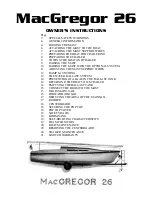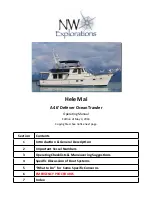
PK-13-GB(V1)
www.jilong.com
6
7
PK-13-GB(V1)
www.jilong.com
IMPORTANT WARNING
INFLATING THE KAYAK
To enhance the enjoyment of your kayak and protect the safety of passengers and
operator using the kayak, always strictly observe the following safety warning:
-This is not a life saving device. Use only under competent supervision. Never allow
diving into this product. Never leave in or near the water when not in use. Never tow
from any vehicle. Adult assembly and operation required.
-Adults should inflate the chambers in numbered.
Excessive inflating the kayak can cause the chambers to burst or cause damage
to the welded seams. Not following the operator’s instructions, which may detail
important inflation and assembly sequences,can cause capsizing and drowning.
-Taking the kayaking safety course and get hands-on training from your kayak
dealer or local kayaking authorities. Review all safety requirements regularly. Never
navigate alone.
-A personal Flotation Device (PFD) is required for each passenger. It is especially
important that children and non-swimmers wear a personal flotation device at all
times. Children and non-swimmers need special instruction in the use of PFD.
-Be careful when stepping or climbing aboard the kayak. Step into the center of the
kayak for maximum stability. Distribute the weight of passengers, gear, tackle box
and accessories evenly so that the kayak sits even front to back and side and to
side. Uneven distribution of persons or loads in the boat can cause capsizing and
drowning.
-Do not use your kayak if you suspect a puncture or leak. It might be unsafe.
-WARNING:BEWARE OF OFFSHORE WINDS AND CURRENTS. These could be
unsafe conditions.
-Follow these rules to avoid drowning, paralysis or other serious injuries.
-WARNING: It is the responsibility of the kayak operator to identify and obey all
local and state laws pertaining to kayak safety and required safety equipment.
Please consult your local authorities to ensure compliance.
-Do not allow unattended children in the kayak. Always make sure that at least one
responsible adult is supervising all children and those who don’t know how to swim
at all times.
-Always maintain the proper kayak safety equipment in an easily accessible place
in your kayak. Indicate clearly emergency phone numbers as well as safety
advisories and rules (such as “No jumping or Diving”)
-The total number of persons and total weight shall not exceed the information
printed on the kayak. Do not exceed the maximum recommended capacities.
Exceeding the data given on the capacity plate can cause capsizing and drowning.
-Select a clean area free of stones, gravel, sticks or other sharp objects.
-Unfold the kayak that it’s laid out flat and locate your pump.
-Use a hand or foot operated air pump to inflate the kayak. Do not use high-
pressure air compressors. It’s very important to follow the numbered sequence:
failure to do so will result in an improperly inflated kayak. Fill each chamber until
it is stiff. Use printed ruler on the kayak to check the main chamber for proper
inflation.
If the kayak is inflated during cold weather or without direct sunlight on the tubes,
care must be taken not to over-inflate the tubes. As the air inside the tubes heats
up due to temperature rises or sunshine, the pressure will increase. The kayak is
not fitted with a safety valve, so the pressure must be monitored at all times.
A
D
B
C
A. Valve cap
B. Inflating mouth
C. Deflation button
D. Protective sheath
Built-in Safety Valve illustration
Structure of the safety valve





































